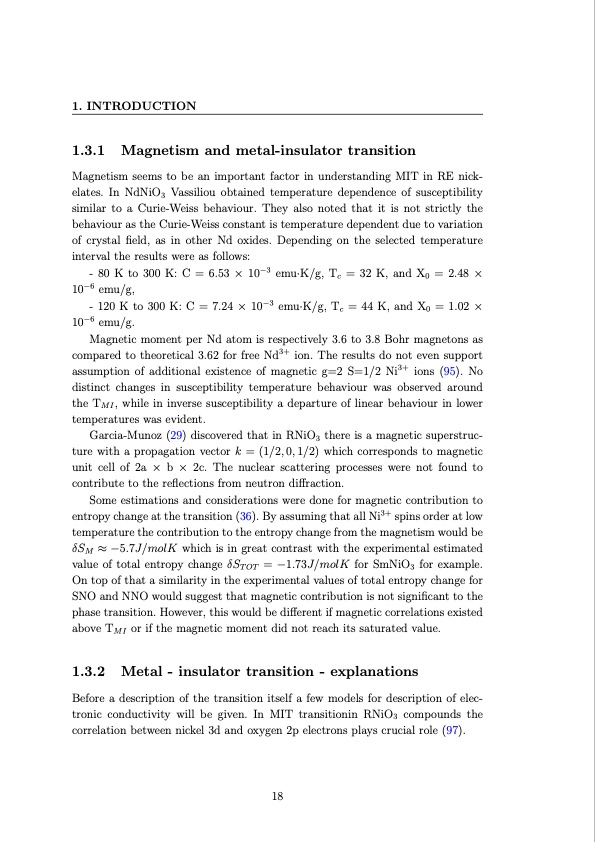
PDF Publication Title:
Text from PDF Page: 039
1. INTRODUCTION 1.3.1 Magnetism and metal-insulator transition Magnetism seems to be an important factor in understanding MIT in RE nick- elates. In NdNiO3 Vassiliou obtained temperature dependence of susceptibility similar to a Curie-Weiss behaviour. They also noted that it is not strictly the behaviour as the Curie-Weiss constant is temperature dependent due to variation of crystal field, as in other Nd oxides. Depending on the selected temperature interval the results were as follows: -80Kto300K:C=6.53×10−3 emu·K/g,Tc =32K,andX0 =2.48× 10−6 emu/g, -120Kto300K:C=7.24×10−3 emu·K/g,Tc =44K,andX0 =1.02× 10−6 emu/g. Magnetic moment per Nd atom is respectively 3.6 to 3.8 Bohr magnetons as compared to theoretical 3.62 for free Nd3+ ion. The results do not even support assumption of additional existence of magnetic g=2 S=1/2 Ni3+ ions (95). No distinct changes in susceptibility temperature behaviour was observed around the TMI, while in inverse susceptibility a departure of linear behaviour in lower temperatures was evident. Garcia-Munoz (29) discovered that in RNiO3 there is a magnetic superstruc- ture with a propagation vector k = (1/2, 0, 1/2) which corresponds to magnetic unit cell of 2a × b × 2c. The nuclear scattering processes were not found to contribute to the reflections from neutron diffraction. Some estimations and considerations were done for magnetic contribution to entropy change at the transition (36). By assuming that all Ni3+ spins order at low temperature the contribution to the entropy change from the magnetism would be δSM ≈ −5.7J/molK which is in great contrast with the experimental estimated value of total entropy change δSTOT = −1.73J/molK for SmNiO3 for example. On top of that a similarity in the experimental values of total entropy change for SNO and NNO would suggest that magnetic contribution is not significant to the phase transition. However, this would be different if magnetic correlations existed above TMI or if the magnetic moment did not reach its saturated value. 1.3.2 Metal - insulator transition - explanations Before a description of the transition itself a few models for description of elec- tronic conductivity will be given. In MIT transitionin RNiO3 compounds the correlation between nickel 3d and oxygen 2p electrons plays crucial role (97). 18PDF Image | Investigation of metal-insulator transition in magnetron sputtered samarium nickelate thin films

PDF Search Title:
Investigation of metal-insulator transition in magnetron sputtered samarium nickelate thin filmsOriginal File Name Searched:
Bilewska_Investigation_of_metal_insulator_transition_in_magnetron_sputtered_samarium.pdfDIY PDF Search: Google It | Yahoo | Bing
Sulfur Deposition on Carbon Nanofibers using Supercritical CO2 Sulfur Deposition on Carbon Nanofibers using Supercritical CO2. Gamma sulfur also known as mother of pearl sulfur and nacreous sulfur... More Info
CO2 Organic Rankine Cycle Experimenter Platform The supercritical CO2 phase change system is both a heat pump and organic rankine cycle which can be used for those purposes and as a supercritical extractor for advanced subcritical and supercritical extraction technology. Uses include producing nanoparticles, precious metal CO2 extraction, lithium battery recycling, and other applications... More Info
| CONTACT TEL: 608-238-6001 Email: greg@infinityturbine.com | RSS | AMP |